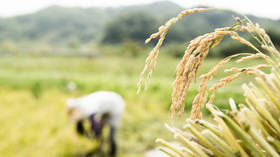India's rice export ban is a wise economic decision ahead of an election year

Videos of panic-purchasing of Indian rice in crowded grocery stores in Texas in the US and Toronto in Canada have gone viral. This followed the July 20 decision by the government of Prime Minister Narendra Modi – which faces a general election next year – to ban the export of non-basmati white rice until further notice.
Because their home nation is the world’s largest rice exporter, shortage worries aren’t entirely irrational among the Indian diaspora. India sells the widely consumed grain in more than 130 countries, accounting for about 40% of the total 55.4 million metric tonnes of global rice traded last year.
Call it erratic human behavior, but hoarding is the most common response to a perceived shortage, at least by those with the resources to do so.
A shop owner of Indian origin in Canada told the media that he had to impose a per-customer purchase limit a day after people, most of them diasporic South Asians, started feeding into the panic and rushing in to scoop up whatever rice they could get their hands on. He then had to throw out overzealous consumers who arrived in groups to buy in bulk.
Much more than the US and Canada, India’s partial ban on rice exports is expected to adversely hit countries that are among the largest buyers of its cheaper varieties of rice, especially low-income ones such as Bangladesh, Senegal, Nepal, and Benin, according to trade experts. This explains why the International Monetary Fund (IMF) asked India to reconsider a decision that may affect poorer countries and cause food insecurity. However, in African countries, where Oryza glaberrima is mostly consumed instead of the Indian Oryza sativa variety, this measure may not have much of an impact.
Back in India, officials contend that they are merely following an ‘India first’ policy at a time when food prices are displaying signs of accelerating. Food price inflation accelerated in June to 4.5% from under 3% in May, owing to spiraling costs of cereals, pulses, tomatoes, and other vegetables. The government has maintained that it had to restrict exports because domestic rice prices were showing “an increasing trend.” According to official data, the retail prices of rice rose by 11.5% over the past year and 3% in just the month of July.
The Indian view, therefore, is that the partial ban on rice exports is more an economic than political matter.
India’s Agriculture Ministry maintains that the government first tried to impose a 20% tax on exports of non-basmati white rice last September to help lower the price and ensure greater availability in the domestic market. Such varieties of rice, as opposed to the more expensive basmati rice, are bought predominantly by India’s middle and lower classes, especially in the rice-eating regions in the south and east. Rice is a staple in the diet of more than 50% of the country’s citizens.
It was when exports of non-basmati white rice were still rising that the government decided to impose the restrictions. The increase in exports was primarily attributable to volatile global prices and adverse weather conditions in other rice-producing countries, such as Thailand and Vietnam. Geopolitical uncertainties also contributed to the surge in demand overseas.
Nevertheless, the fear of shortages in wealthier countries is misplaced because non-basmati white rice constitutes only around 25% of India’s total rice exports. Furthermore, most of these more prosperous Western countries buy basmati rice and non-basmati parboiled rice, which form the bulk of India’s exports and for which there are no export restrictions as of now. Besides, rice isn’t a staple in the West for the majority of the population. Meanwhile, traders of basmati varieties are upbeat about getting higher prices in the global market amid a likely spike in demand.
For India, curbing food inflation locally is not an unreasonable proposition. Although the stock of rice in Food Corporation of India (FCI) warehouses is high enough, sowing this year has fallen in some areas, and the news from rice-producing states such as Chhattisgarh and Odisha has not been positive either, especially because of the vagaries of weather. India’s major rice-producing states are West Bengal, Uttar Pradesh, Andhra Pradesh, Punjab, Tamil Nadu, and Bihar, as well as Chhattisgarh and Odisha. As many as 72% of the country’s rice farms are located in these states, and they produce more than 75% of the nation’s rice. According to a government statement, its rice procurement has reached 52.06 million tonnes so far in the ongoing 2022-23 marketing season. This has benefitted 1.12 crore (11.2 million) farmers who were paid a total minimum support price (MSP) of Rs 1.6 lakh crore (1.6 trillion Indian rupees). MSP is a form of market intervention by the government in case there is a sharp fall in the prices of select agricultural produce. FCI, along with state agencies, procures paddy (rice before threshing) under this price support scheme.
Resoundingly, the Indian government wants to meet food security goals in the wake of global uncertainties, changing weather patterns, as well as unforeseen incidents that may require the mobilization of resources, including the supply of food grains. Though ‘India first’ priorities can be perceived as disastrous long-term diplomatic moves by a key leader of the Global South, it doesn’t look so – not yet. Moreover, the government has said it is open to negotiating country-to-country on these export restrictions if there is an emergency.
Again, any economic decision often also has a political angle to it. In the run-up to the general elections next year in India, it is natural for the incumbent government to cover all bases. Food inflation and concomitant hardship for the people could make or break poll prospects for even a formidable political formation.
A hungry stomach certainly means an angry voter.
The statements, views and opinions expressed in this column are solely those of the author and do not necessarily represent those of RT.















